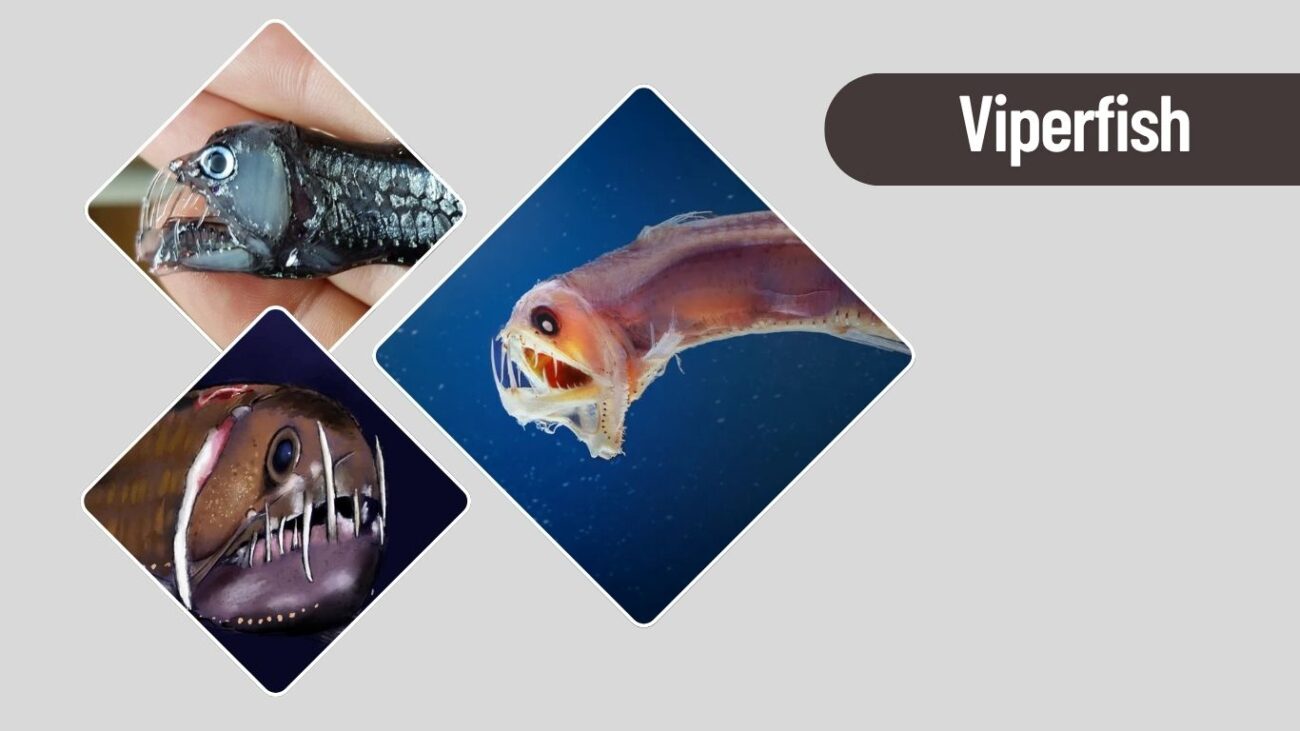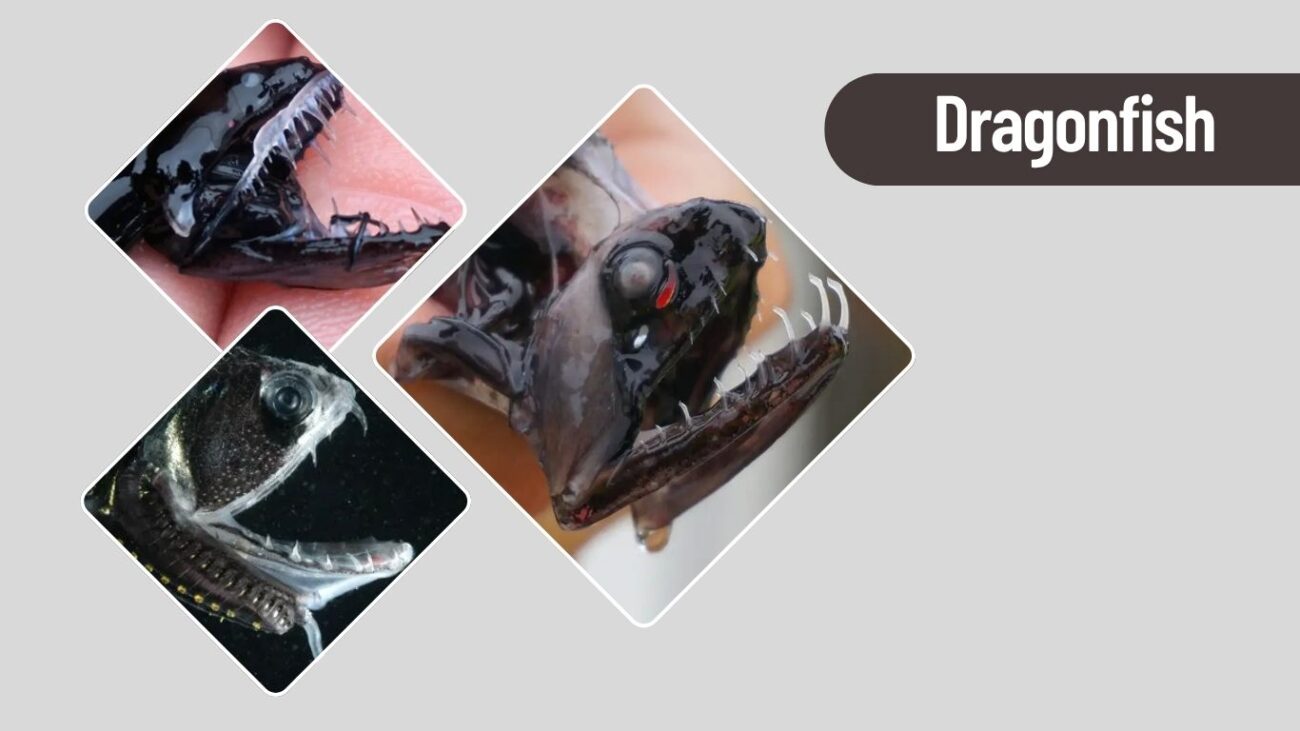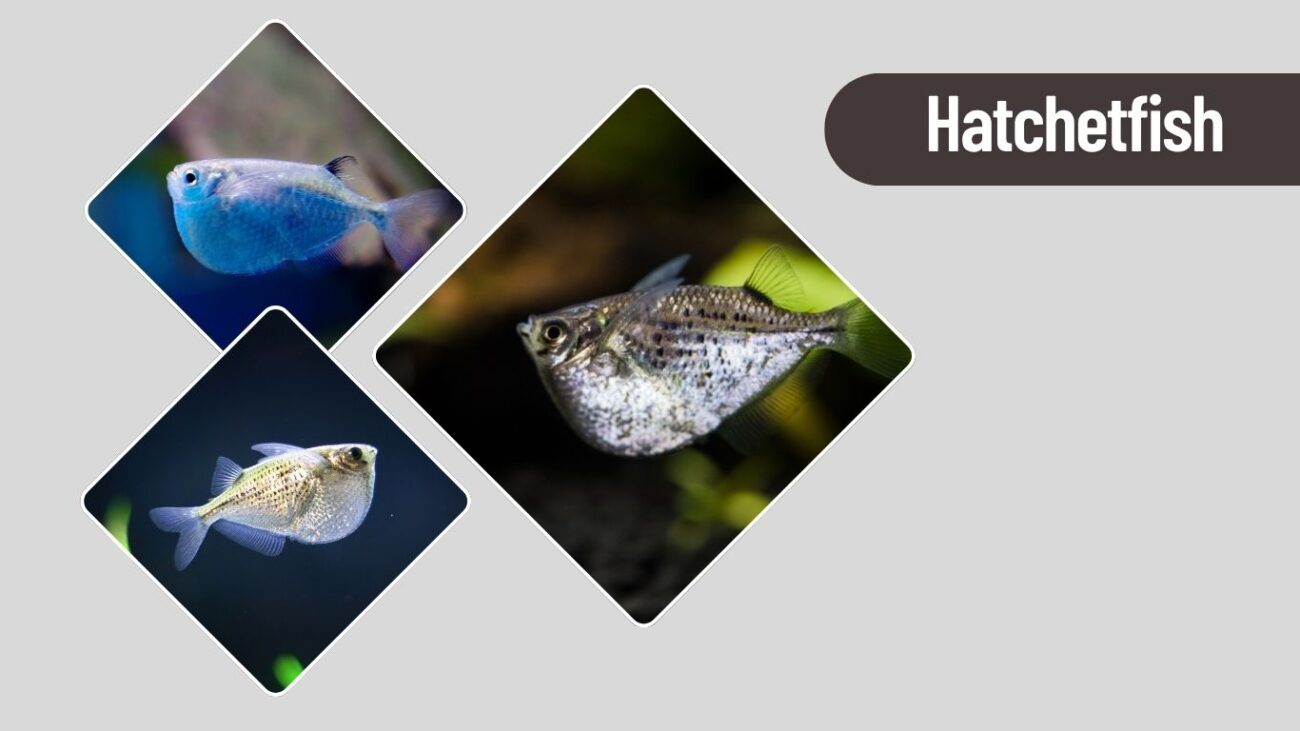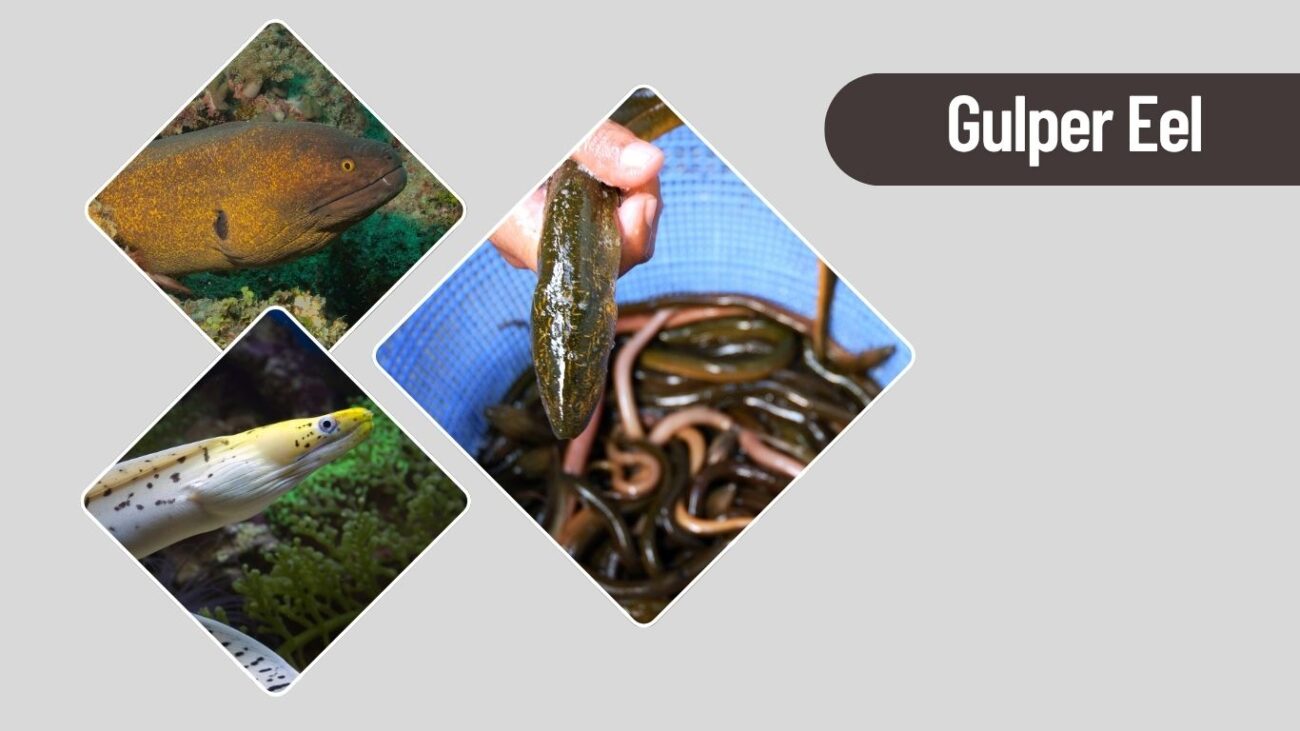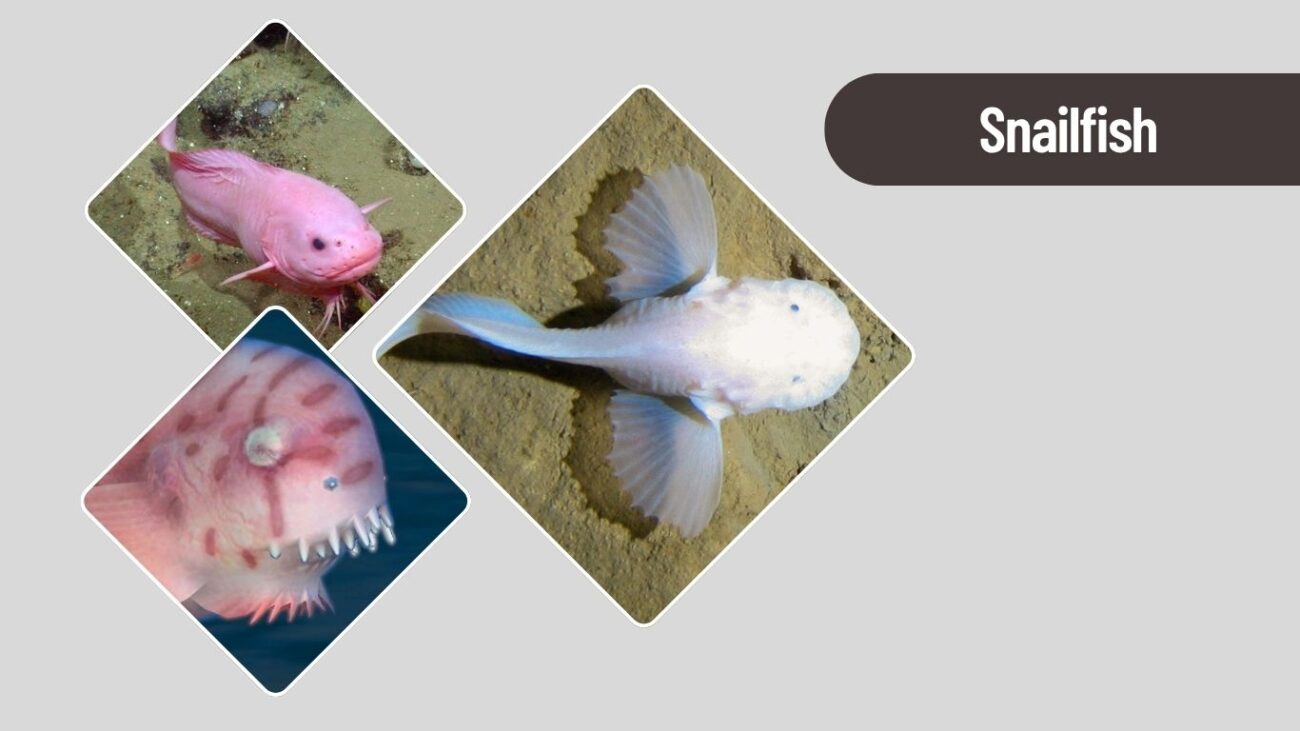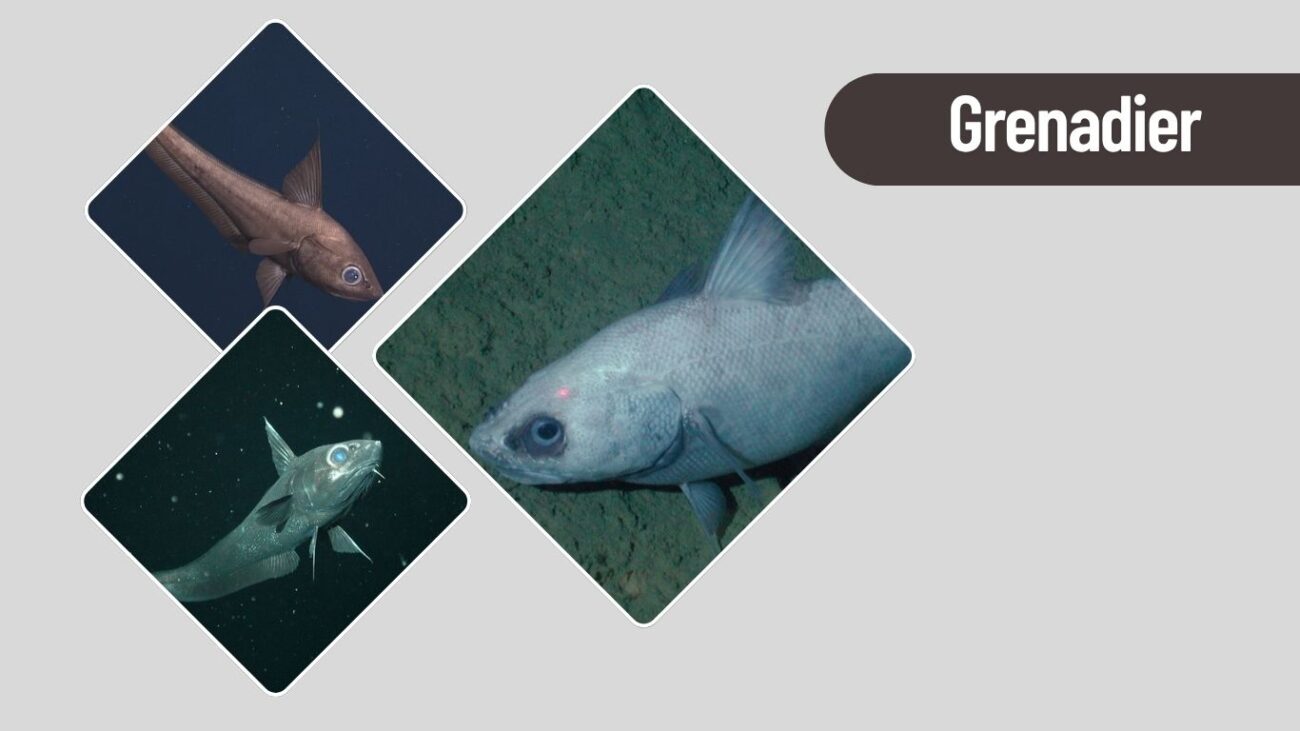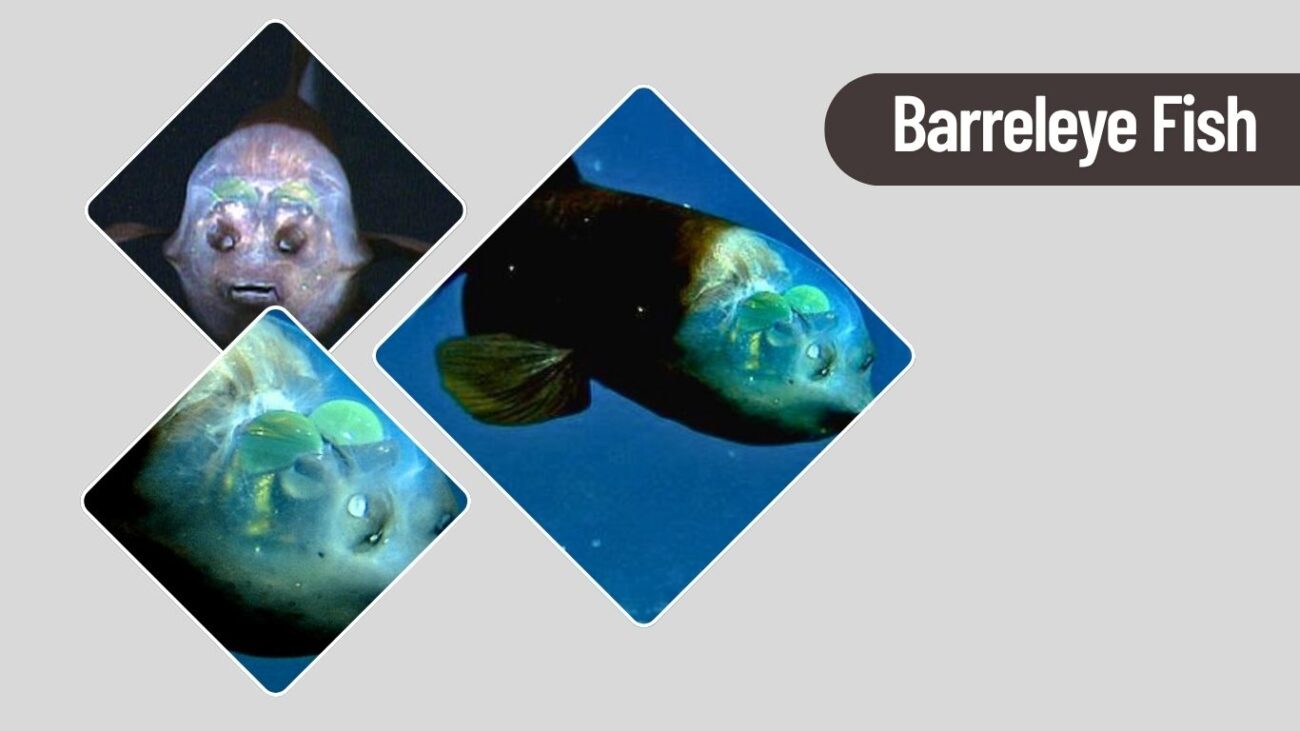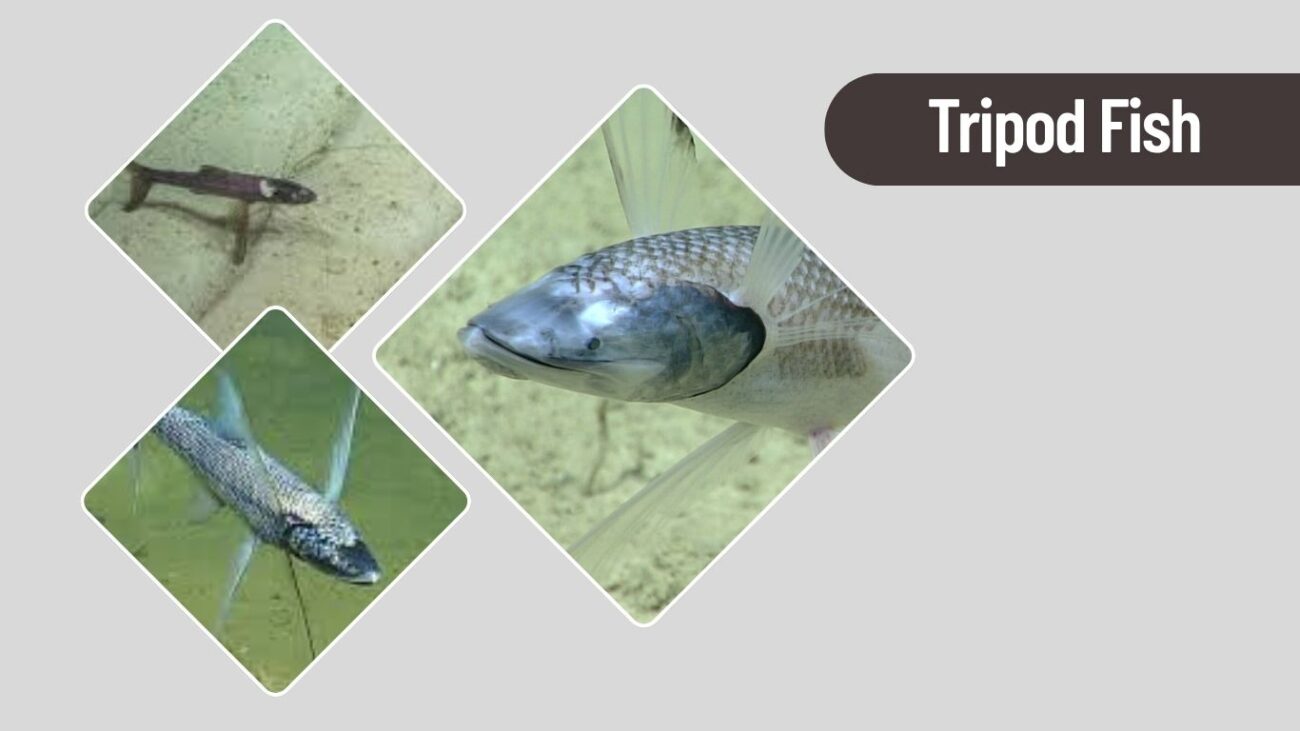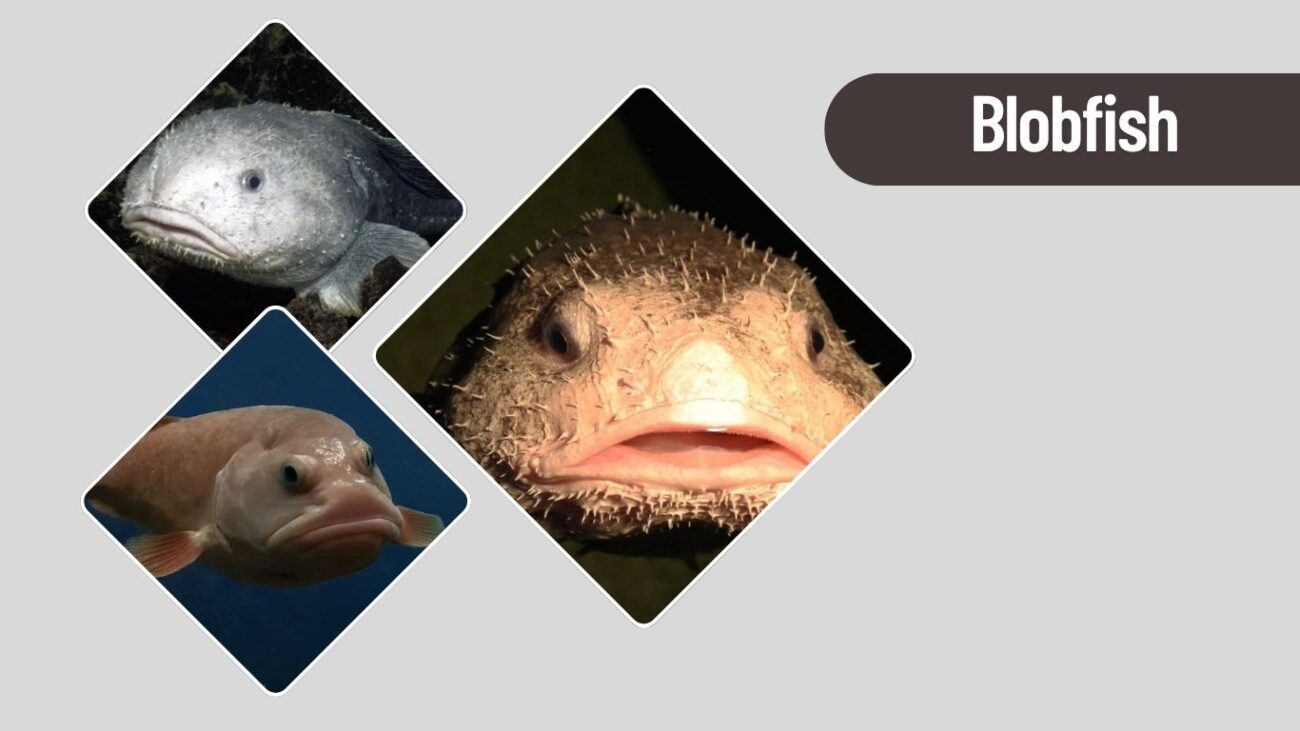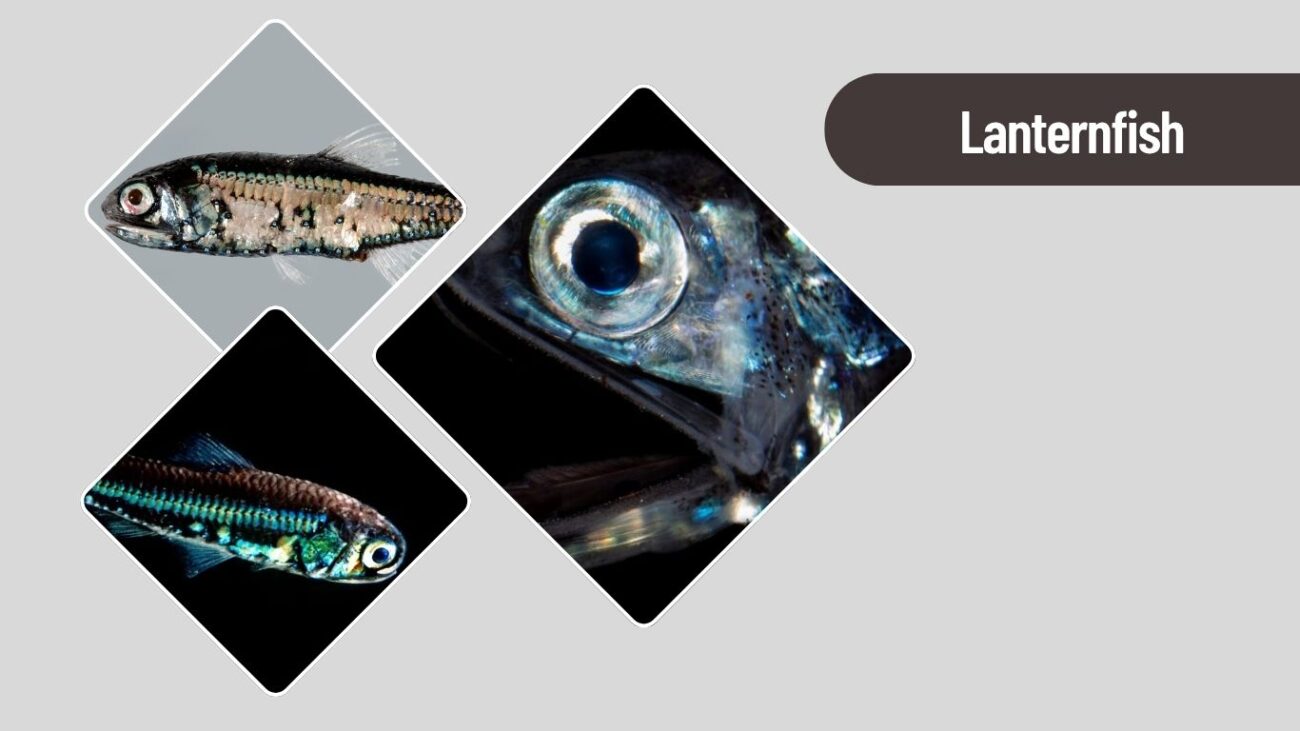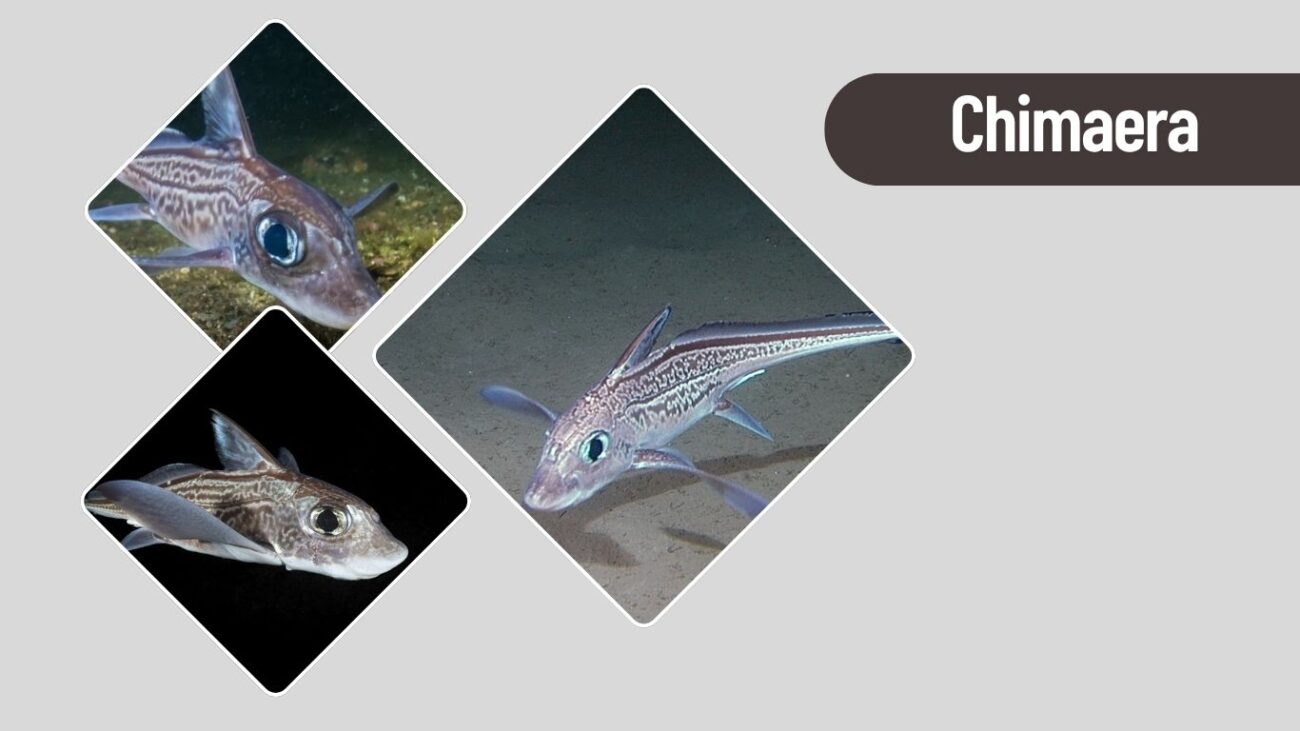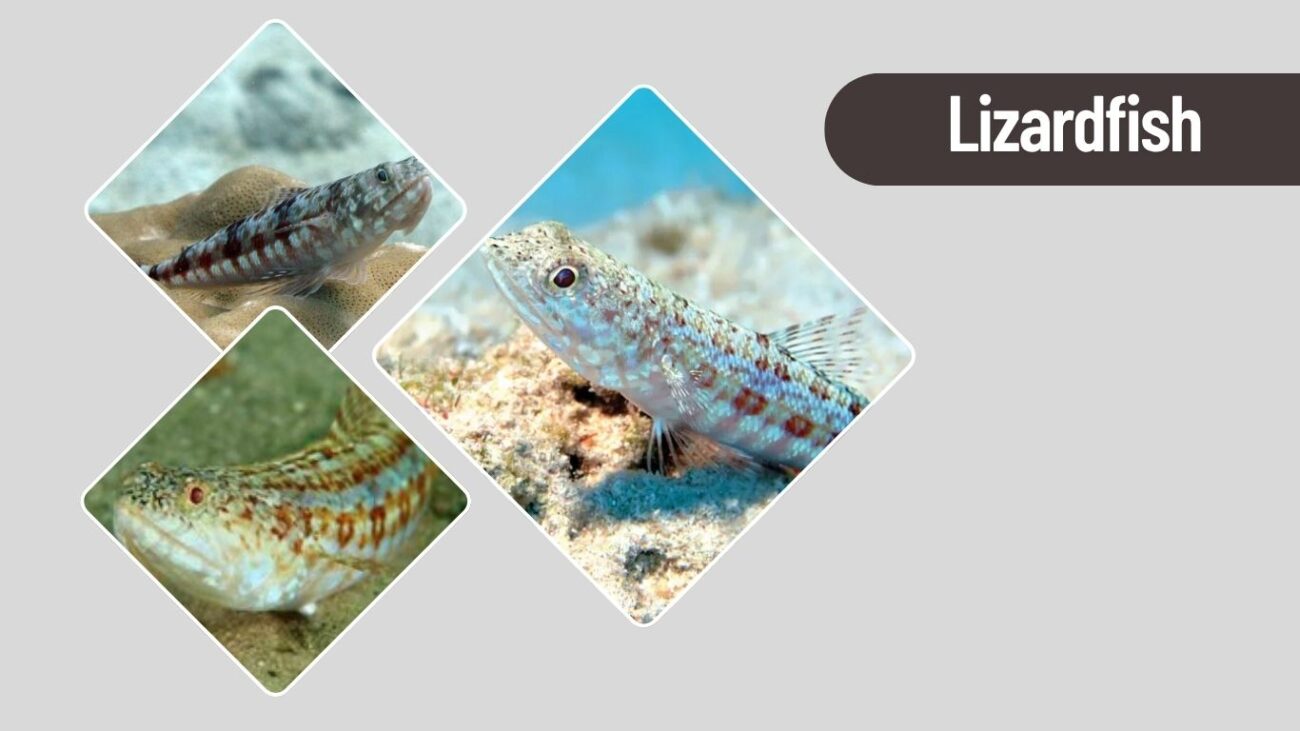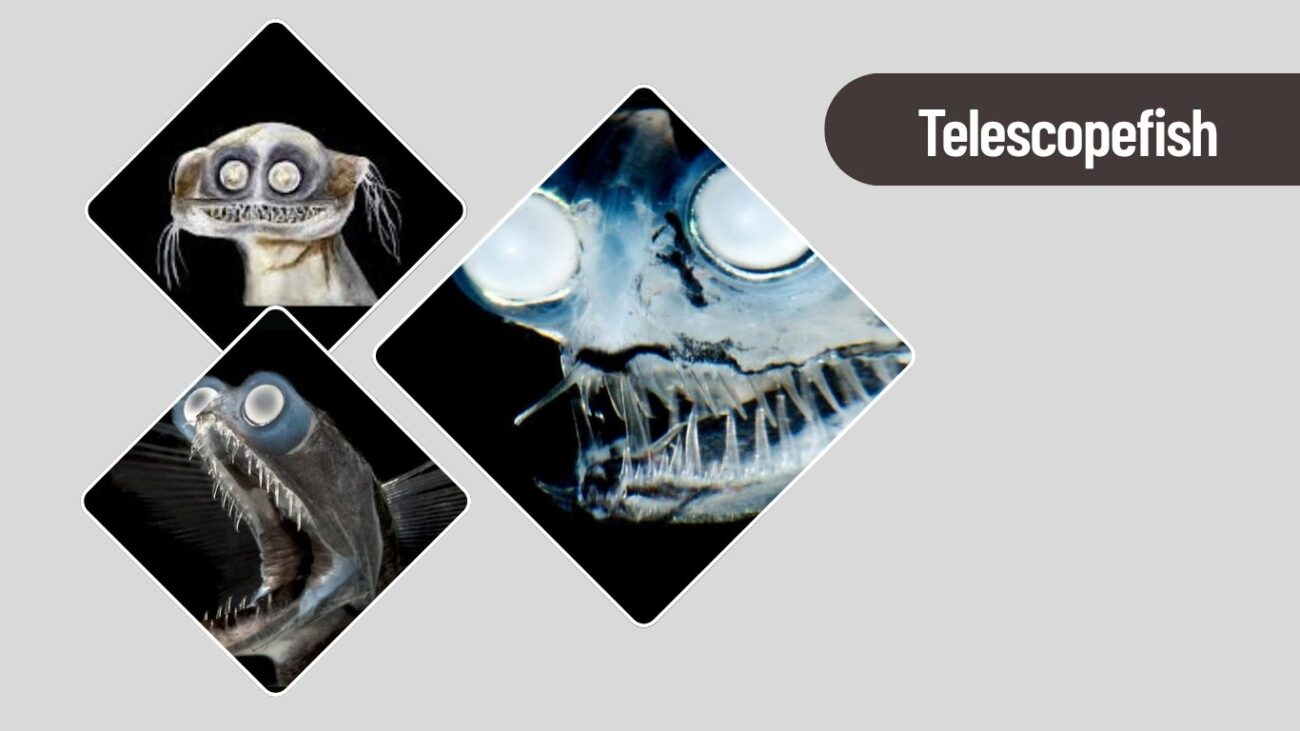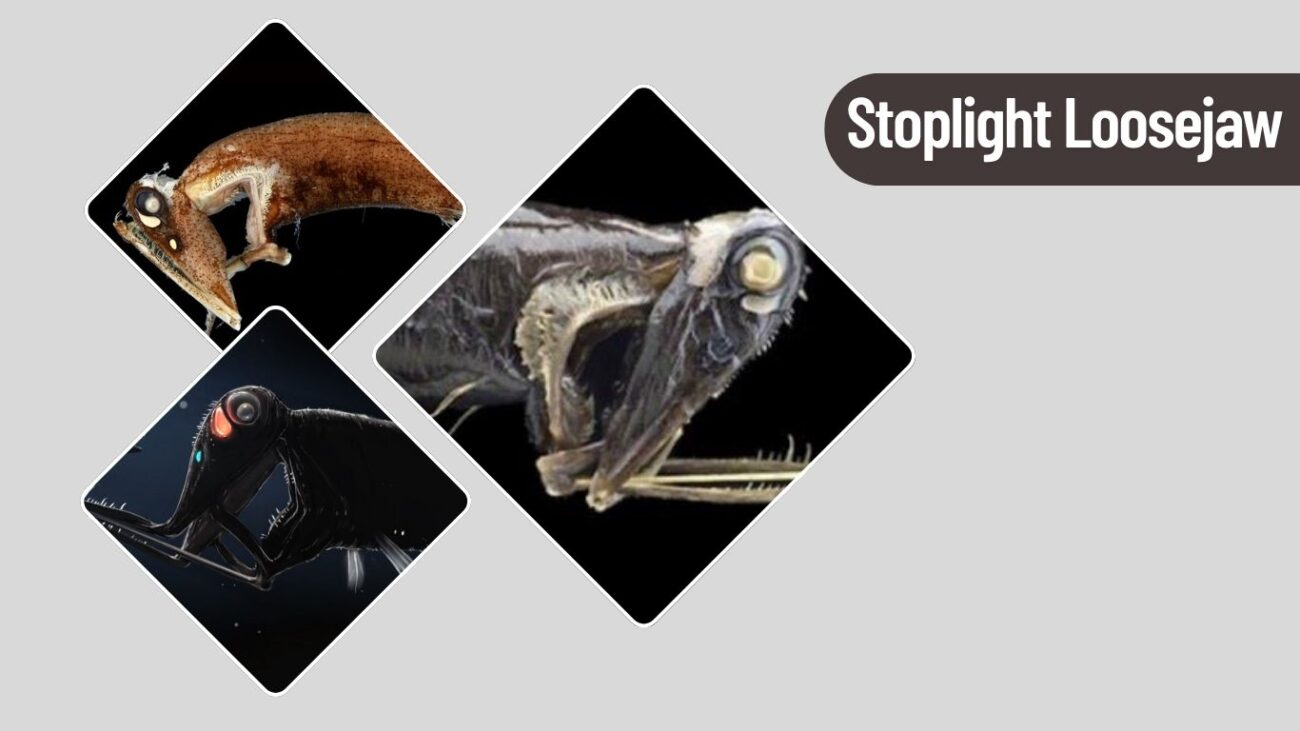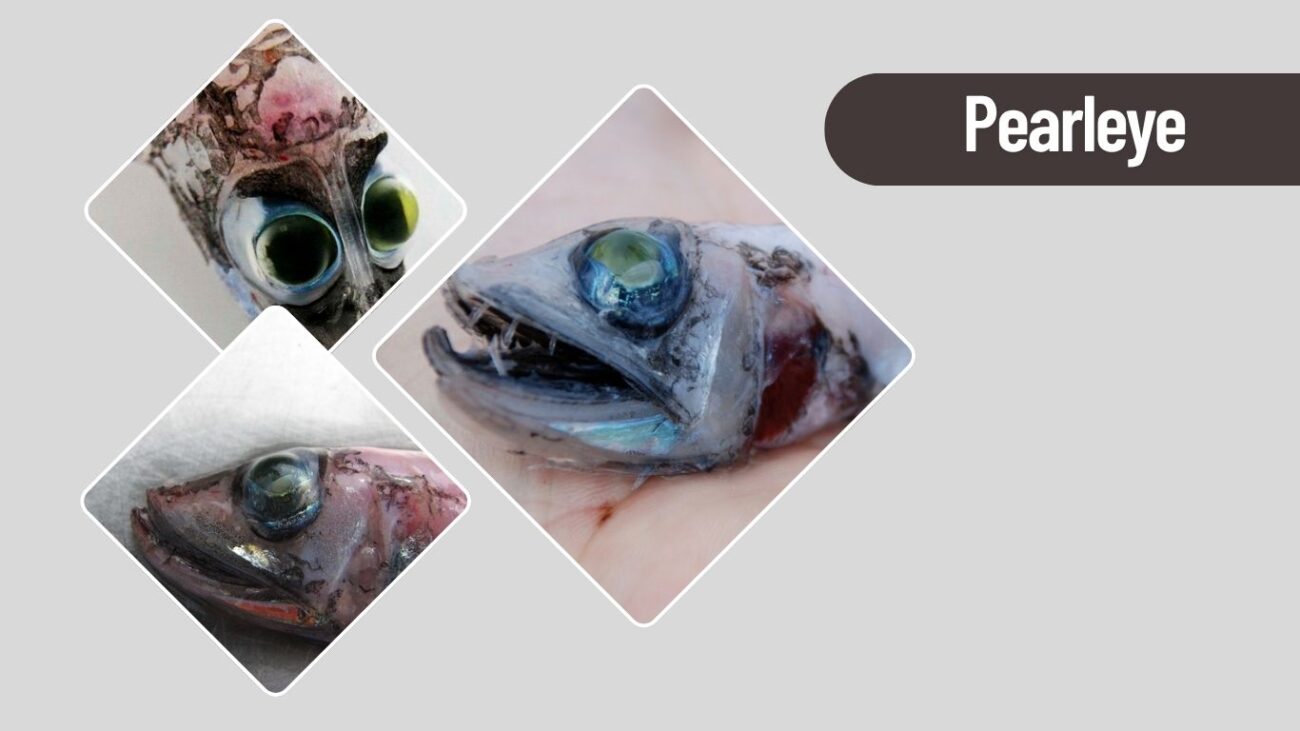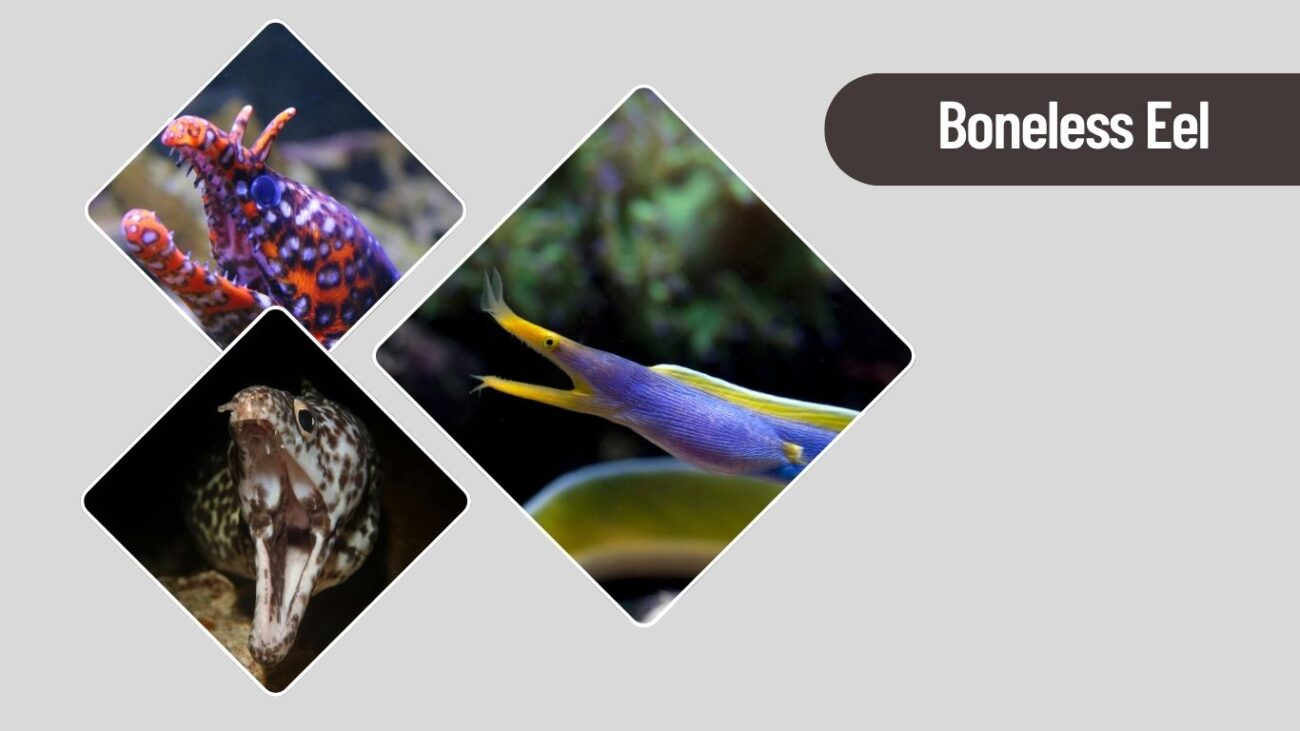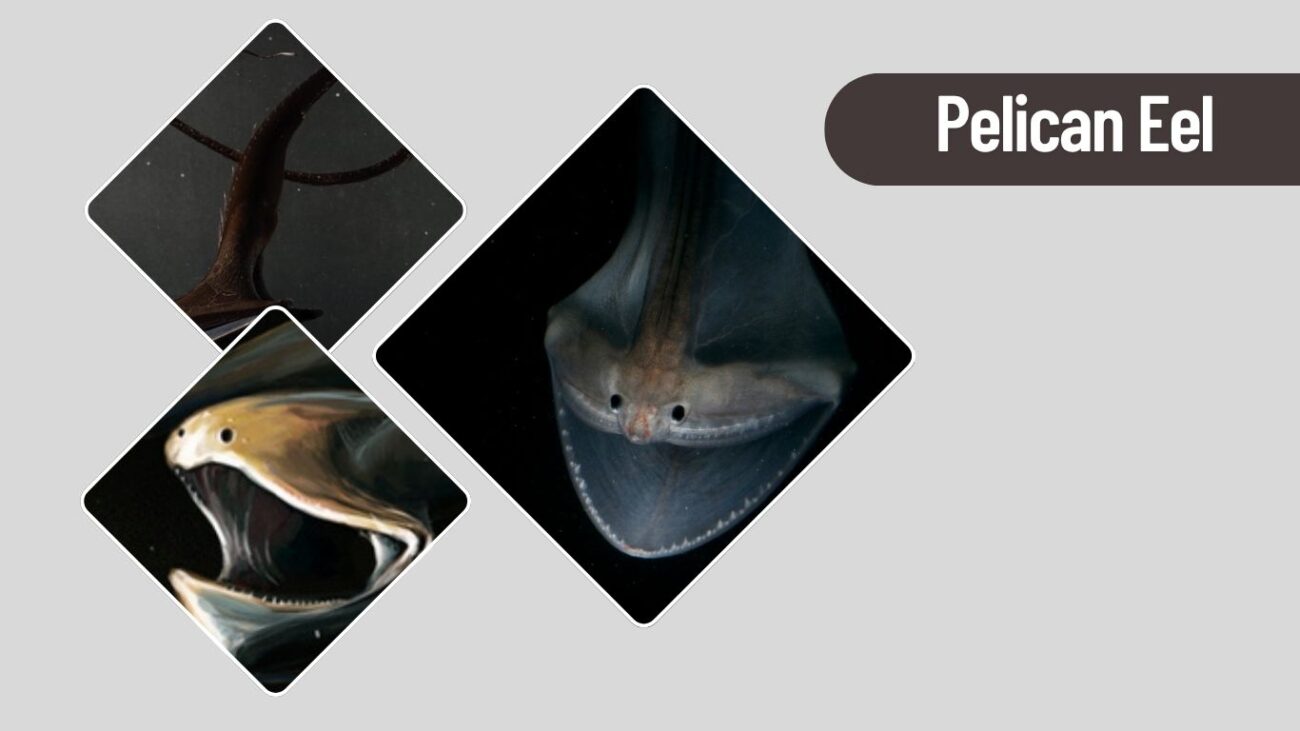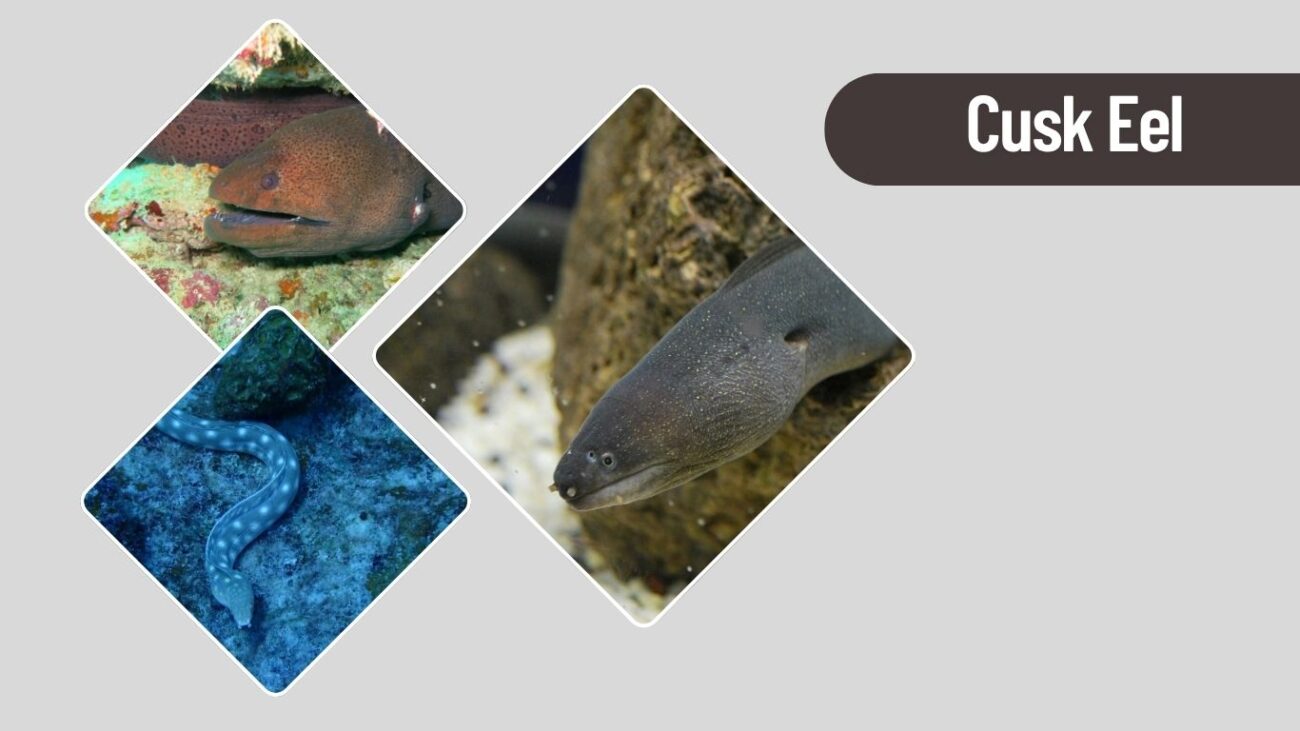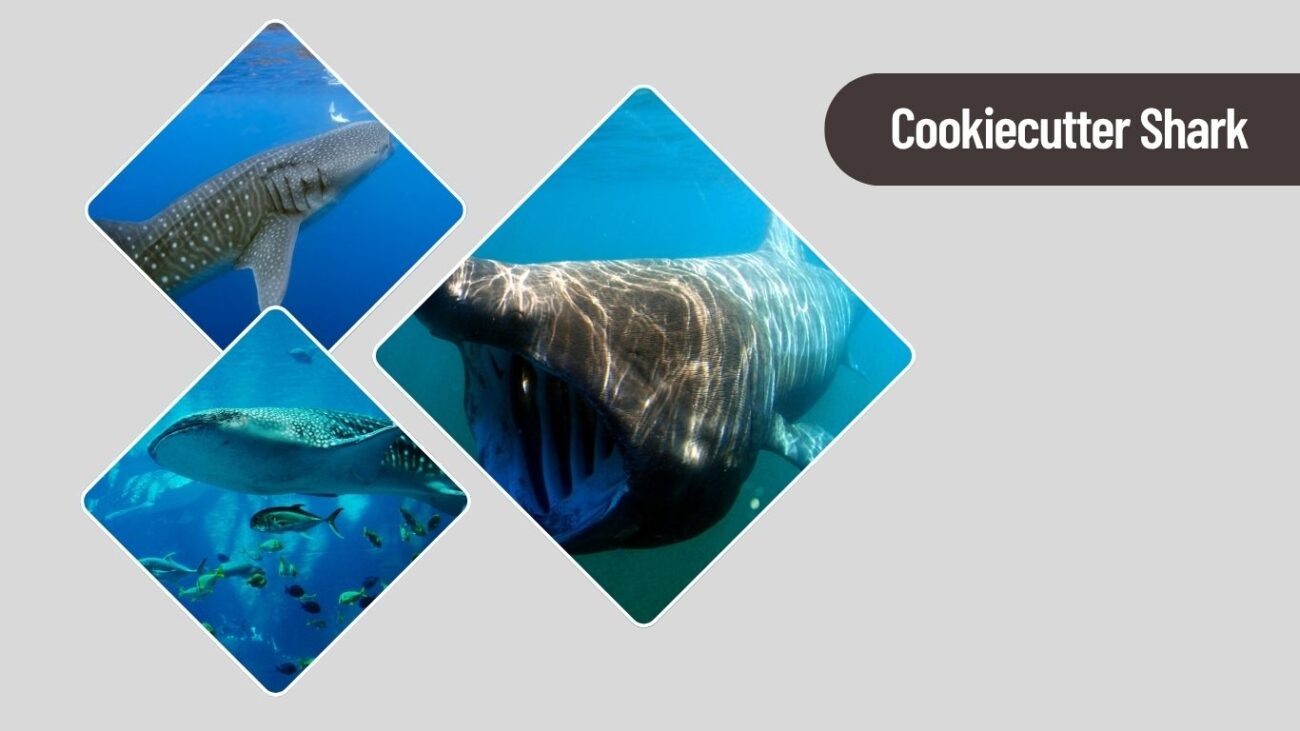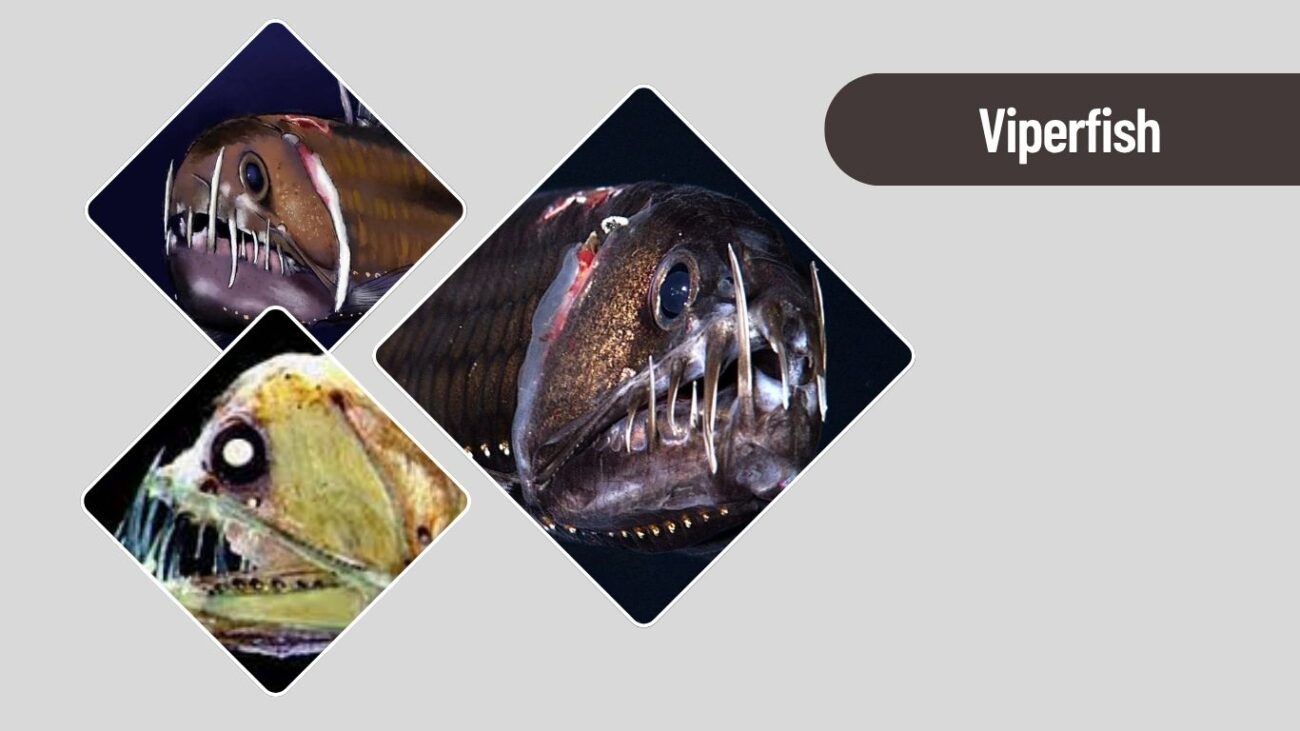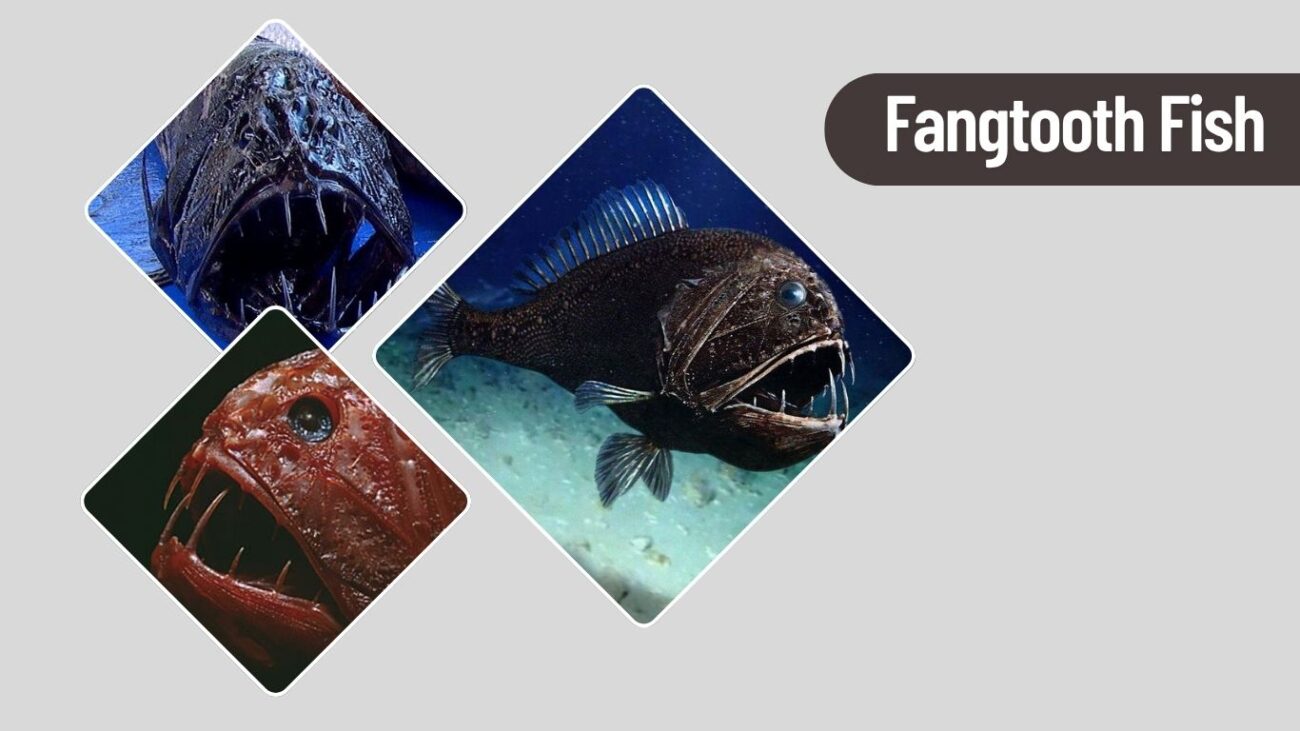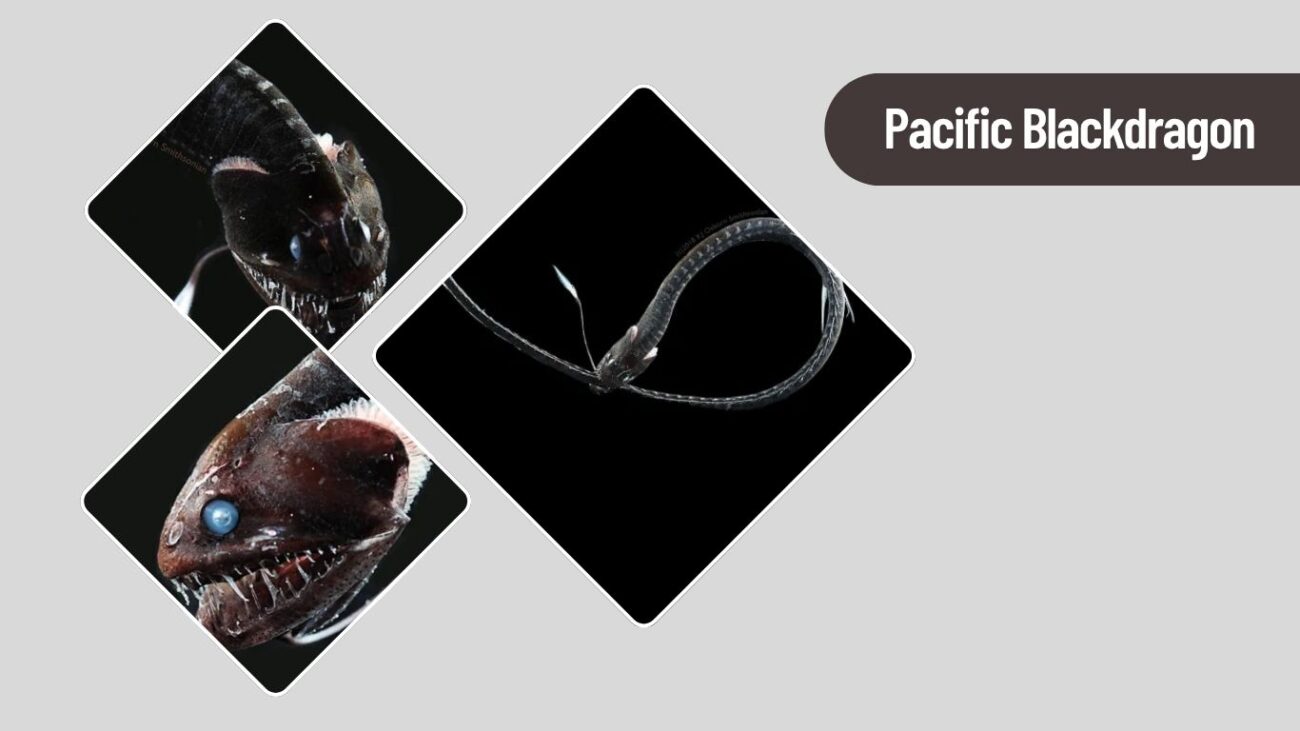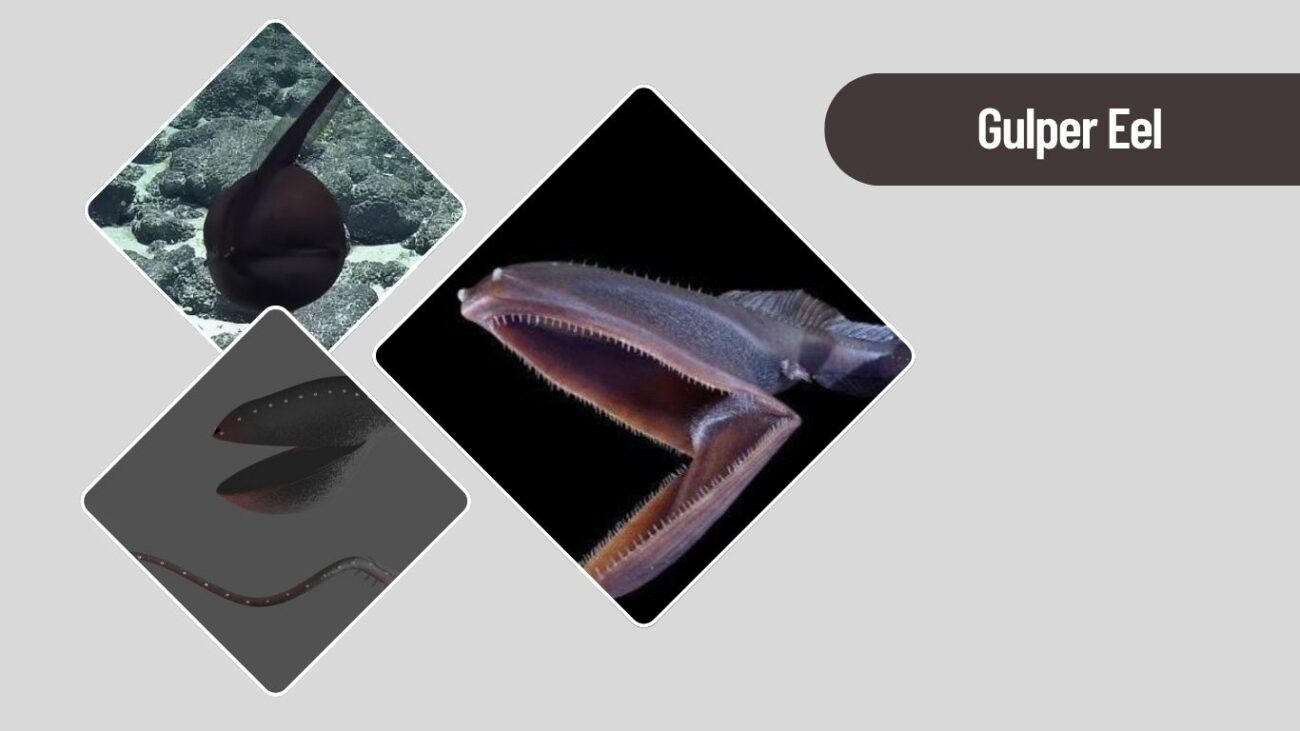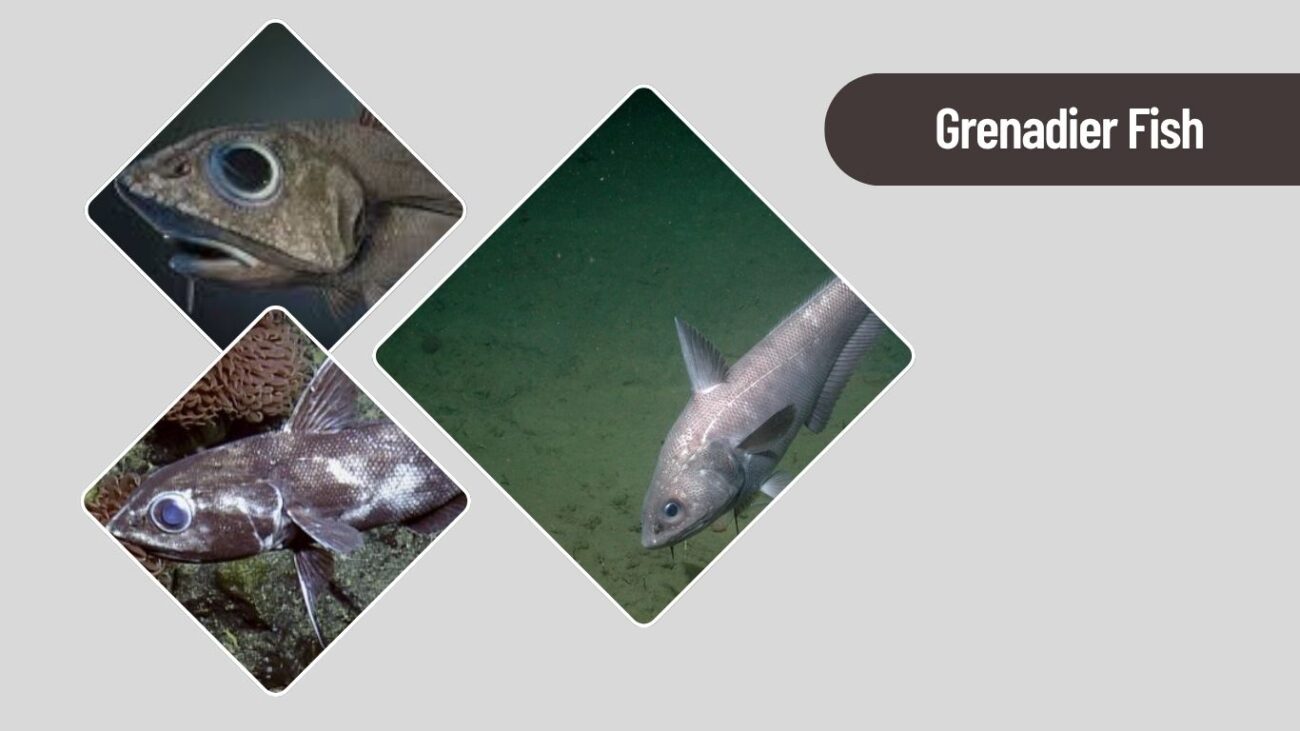The deep sea is a mysterious world where sunlight never reaches and pressure is extreme—yet it’s teeming with extraordinary life. Among the most intriguing creatures are deep sea fish, uniquely adapted to survive in total darkness and crushing depths. From glowing predators and fang-filled jaws to transparent heads and expandable stomachs, this list of 34 deep sea fish reveals the alien-like diversity thriving far below the ocean’s surface. Dive in and discover the strange and captivating residents of the deep.
1. Anglerfish – Iconic Deep Sea Predator
The anglerfish is one of the most well-known and eerie-looking deep sea fish, famous for the glowing lure that extends from its head. This bizarre adaptation helps it attract prey in the pitch-black depths of the ocean.
Identification
- Large head with a bioluminescent lure (esca) dangling from a modified dorsal fin
- Wide, toothy mouth with translucent, inward-facing fangs
- Females are much larger than males (up to 3 feet long)
- Dark brown or black rough skin for camouflage
- Males are tiny and often fuse to females in some species (parasitic mating)
Habitat and Depth Range
Anglerfish live in the bathypelagic zone at depths of 2,000 to 9,800 feet (600 to 3,000 meters). Found in all major oceans, especially in the Atlantic and Antarctic deep waters.
Behavior and Adaptations
The anglerfish uses its glowing lure to attract prey close enough to ambush. In some species, the male permanently attaches to the female for reproduction—a rare phenomenon in the animal kingdom. With slow movements and expandable jaws, anglerfish can devour prey nearly as large as themselves.
2. Fangtooth Fish – Ferocious Deep Sea Dweller
The fangtooth fish is a small but fearsome deep sea predator, best known for its enormous fangs—the largest, in proportion to body size, of any fish in the ocean. Despite its terrifying appearance, it’s only a few inches long.
Identification
- Large, dagger-like teeth that overlap the lower jaw
- Big head with sunken, small eyes
- Dark brown to black, armored-like body
- Adults grow up to 6–7 inches long
- Juveniles look dramatically different from adults
Habitat and Depth Range
Fangtooth fish live in temperate and tropical oceans, usually between 6,500 to 16,500 feet (2,000 to 5,000 meters) deep, though they can migrate to shallower depths at night.
Behavior and Feeding
They feed on smaller fish and crustaceans, using their fangs to grasp prey in the dark. Their ability to survive extreme pressure and low oxygen makes them a well-adapted hunter in the deep sea.
3. Viperfish – Needle-Toothed Deep Sea Predator
The viperfish is another terrifying-looking but fascinating deep sea fish, recognized by its long, needle-like teeth and hinged lower jaw. It uses light-producing organs to lure prey in the darkness.
Identification
- Elongated body with needle-sharp teeth and hinged jaw
- Bioluminescent photophores along the body and under the eye
- Grows up to 12–24 inches long
- Dark silver, blue, or black coloring
- Large eyes for detecting movement in low light
Habitat and Depth Range
Viperfish are found at depths of 2,000 to 5,000 feet (600 to 1,500 meters) in tropical and temperate ocean waters around the globe.
Behavior and Feeding
Viperfish use their bioluminescent lure to attract small fish and crustaceans. When prey approaches, they strike quickly, impaling it with their long fangs. They are solitary and known for making vertical migrations closer to the surface at night.
4. Dragonfish – Bioluminescent Deep Sea Hunter
The dragonfish is a small but deadly deep sea fish with an intimidating appearance. Known for its glowing lure, fang-like teeth, and ability to produce red light (rare in the deep), it’s a master of stealth hunting in darkness.
Identification
- Slender, dark body with bioluminescent barbel (chin whisker)
- Long, sharp teeth and a wide jaw
- Glowing photophores along its body
- Typically 6 to 8 inches in length
- Can emit invisible red light to hunt without being seen
Habitat and Depth Range
Dragonfish inhabit depths of 1,600 to 5,000 feet (500 to 1,500 meters) in tropical and subtropical oceans around the world.
Behavior and Hunting
Dragonfish use bioluminescence to lure and stun prey in total darkness. Their red light gives them an advantage over other deep sea animals that can’t detect that wavelength, making them invisible hunters in the deep.
5. Hatchetfish – Reflective Deep Sea Drifter
The hatchetfish is a small, silvery deep sea fish named for its hatchet-shaped body. It is best known for its glowing underside and mirror-like skin, which help it evade predators in the twilight zone.
Identification
- Thin, laterally compressed body with a sharp, sloped underside
- Large, upward-facing eyes
- Metallic silver color with photophores for counter-illumination
- Grows up to 4 inches long
- Transparent bones visible in many species
Habitat and Depth Range
Found at depths of 650 to 4,500 feet (200 to 1,400 meters) in tropical and temperate oceans worldwide, especially in midwater regions.
Behavior and Defense
Hatchetfish use counter-illumination to blend in with light filtering from above, making them nearly invisible to predators below. They feed on plankton and small crustaceans and perform nightly vertical migrations to shallower waters.
6. Gulper Eel – Balloon-Mouthed Deep Sea Feeder
The gulper eel, also called the pelican eel, is a bizarre deep sea fish known for its enormous, expandable mouth and long, whip-like tail. It looks like something from science fiction and is rarely seen alive.
Identification
- Huge, pouch-like mouth that can engulf prey larger than its body
- Narrow body with a long, whip-like tail
- Small eyes and bioluminescent tail tip used to attract prey
- Typically grows up to 6 feet long
- Thin, dark, rubbery skin
Habitat and Depth Range
Inhabits depths of 1,600 to 9,800 feet (500 to 3,000 meters) in temperate and tropical oceans worldwide.
Behavior and Feeding
The gulper eel uses its glowing tail as a lure in the darkness. When prey swims close, it snaps its massive jaws shut, swallowing food whole. Despite its dramatic look, it moves slowly and is a gentle drifter in the deep.
7. Snailfish – Deepest Living Fish on Earth
The snailfish is a gelatinous, soft-bodied fish that holds the record for surviving at the deepest depths of the ocean. Though it looks fragile, it thrives under crushing pressures where few other vertebrates can survive.
Identification
- Smooth, scaleless body with soft skin
- Large head, small eyes, and tapering tail
- Pale pink, white, or translucent color
- Size ranges from 4 to 12 inches, depending on species
- Adapted to extreme pressure with flexible bones
Habitat and Depth Range
Some snailfish species have been found at depths beyond 27,000 feet (8,200 meters), especially in trenches like the Mariana Trench and Japan Trench.
Behavior and Survival
Snailfish feed on tiny crustaceans and marine snow. Their jelly-like bodies help them survive under intense pressure, where bones would otherwise crush. They’re among the most pressure-tolerant vertebrates known.
8. Grenadier (Rattail Fish) – Common Deep Sea Bottom-Dweller
The grenadier, also known as the rattail fish, is one of the most common deep sea fish, frequently seen near the ocean floor. Its large head, tapering tail, and sluggish movements make it well-adapted to life in the deep.
Identification
- Large head with big eyes and a pointed snout
- Long, tapering tail resembling a rat’s tail
- Soft, scaleless or loosely scaled body
- Typically 12 inches to 4 feet long
- Often gray or brown with a chin barbel
Habitat and Depth Range
Grenadiers are found worldwide at depths of 650 to 20,000 feet (200 to 6,000 meters), especially on continental slopes and abyssal plains.
Behavior and Diet
They are slow-moving scavengers, feeding on crustaceans, worms, and decaying organic matter. Their large eyes help them spot food in the dark, and they’re frequently observed in deep-sea exploration footage.
9. Barreleye Fish – Transparent-Headed Deep Sea Wonder
The barreleye fish is a fascinating and unusual deep sea species known for its transparent dome-shaped head and rotating, tubular eyes that can look upward or forward.
Identification
- Transparent head revealing internal organs and green eyes
- Small mouth and short, flat body
- Eyes are barrel-shaped and can rotate
- Typically grows up to 6 inches long
- Silvery body with a soft, jelly-like appearance
Habitat and Depth Range
Inhabits depths of 1,600 to 2,600 feet (500 to 800 meters) in the Pacific Ocean, especially off California and Hawaii.
Behavior and Vision
Barreleye fish float motionless in the deep, watching for prey above. Their transparent head helps protect their sensitive eyes from predators and bright bioluminescence, making them one of the most visually unique fish in the ocean.
10. Tripod Fish – Standing Deep Sea Bottom Feeder
The tripod fish is a rare and fascinating species that “stands” on the ocean floor using three long, stiff fin extensions. It patiently waits for food to drift past, making it one of the strangest ambush predators in the deep.
Identification
- Elongated, pale body with three long fins (two pelvic, one tail)
- Long pectoral fins used for sensing water movement
- Grows up to 14 inches in length
- Translucent skin with minimal pigmentation
- Small eyes and upward-facing mouth
Habitat and Depth Range
Found on abyssal plains at depths of 3,300 to 15,000 feet (1,000 to 4,500 meters) in oceans worldwide, particularly the Atlantic and Pacific.
Behavior and Feeding
The tripod fish stands motionless on its fins, letting currents bring plankton and small organisms to its mouth. It uses its pectoral fins like antennae to detect prey in complete darkness.
11. Black Swallower – Deep Sea Glutton
The black swallower is a small, dark-colored deep sea fish known for its ability to consume prey larger than itself. Its massively expandable stomach makes it one of the ocean’s most extreme feeders.
Identification
- Thin, elongated black body
- Large head with fang-like teeth
- Expandable stomach that can swell to several times its body size
- Grows to about 10 inches long
- Scaleless, soft skin
Habitat and Depth Range
Typically found at depths of 2,300 to 9,000 feet (700 to 2,750 meters) in tropical and subtropical deep oceans, especially in the Atlantic.
Behavior and Diet
It ambushes large prey, swallows them whole, and stores them in its stomach for extended digestion. Sometimes, its meals decompose before digestion finishes, causing lethal bloating—a rare but documented occurrence.
12. Blobfish – Deep Sea Symbol of Soft Adaptation
The blobfish has become an internet icon due to its saggy, gelatinous appearance when brought to the surface—but in its natural deep sea environment, it’s a streamlined and well-adapted bottom dweller.
Identification
- Soft, gelatinous body with minimal muscle
- Flattened head with a wide mouth and small eyes
- Usually pinkish-gray in color
- Grows up to 12 inches (30 cm) long
- Looks “blobby” at the surface due to pressure changes
Habitat and Depth Range
Lives at depths of 2,000 to 4,000 feet (600 to 1,200 meters), mostly off the coasts of Australia, New Zealand, and Tasmania.
Behavior and Adaptations
Blobfish don’t actively hunt—they simply float above the seafloor, sucking in small crustaceans or organic particles. Their bodies are less dense than water, allowing them to hover with minimal energy in high-pressure environments.
13. Lanternfish – Bioluminescent Deep Sea Swimmer
The lanternfish is one of the most abundant deep sea fish in the world. It’s named for the light-producing photophores along its body, which help with camouflage and communication in dark waters.
Identification
- Small, torpedo-shaped body (typically 1–6 inches long)
- Rows of bioluminescent photophores along the sides and belly
- Silvery or dark coloration depending on species
- Large eyes adapted to low light
Habitat and Depth Range
Found in all the world’s oceans, mostly at depths of 650 to 3,300 feet (200 to 1,000 meters), with nightly migrations closer to the surface.
Behavior and Importance
Lanternfish are vital to ocean food chains, feeding whales, squid, and larger fish. Their daily vertical migrations also help move carbon from surface waters to the deep sea—a process called the biological pump.
14. Coffinfish – Deep Sea Puffer Relative
The coffinfish is a strange, slow-moving deep sea fish related to anglerfish and frogfish. It’s named for its boxy, swollen appearance and unusual ability to inflate its body when threatened.
Identification
- Globular body with loose, spiny skin
- Large head and mouth with small lure above it
- Can inflate its body like a pufferfish
- Usually 6–12 inches in size
- Pinkish, reddish, or brownish in color
Habitat and Depth Range
Found at depths of 650 to 6,600 feet (200 to 2,000 meters), especially off the coasts of Australia and New Zealand.
Behavior and Defense
The coffinfish is a bottom-dweller that uses ambush tactics. It inflates its body when threatened, making it harder for predators to swallow. It also can hold its breath for several minutes—a rare trait among fish.
15. Chimaera (Ghost Shark) – Ancient Deep Sea Cartilaginous Fish
Chimaeras, also known as ghost sharks, are close relatives of sharks and rays, but they branched off over 400 million years ago. Their smooth, spooky appearance gives them their ghostly nickname.
Identification
- Smooth body with long, tapering tail
- Large eyes and flat, rabbit-like teeth
- Prominent dorsal spine (often venomous)
- Size ranges from 2 to 5 feet long
- Colors vary from gray to bluish-silver
Habitat and Depth Range
They live in temperate and cold deep waters, typically 1,600 to 6,500 feet (500 to 2,000 meters) deep across all major oceans.
Behavior and Traits
Chimaeras feed on bottom-dwelling invertebrates, using electroreceptors in their snout to detect prey. Unlike sharks, they don’t have replaceable teeth, and males have clasper-like structures on their heads for mating—unique among fish.
16. Lizardfish – Sharp-Toothed Deep Sea Ambusher
The lizardfish is a long-bodied predator named for its reptilian appearance and sharp, needle-like teeth. It lies in wait, buried in sediment or hovering near the bottom, ready to strike at passing prey.
Identification
- Slender, torpedo-shaped body
- Long, pointed jaw lined with sharp teeth
- Large eyes and forked tail
- Typically grows up to 8–24 inches, depending on species
- Brown, gray, or silver with subtle markings
Habitat and Depth Range
Found at depths from 650 to 3,300 feet (200 to 1,000 meters) in tropical and subtropical oceans, often on the continental slope or seabed.
Behavior and Feeding
Lizardfish are ambush predators, waiting motionless and then darting to capture small fish and invertebrates. Some species have bioluminescent patches to blend in with dim surroundings or lure prey.
17. Telescopefish – Long-Fanged Deep Sea Gazer
The telescopefish is a strange deep sea species recognized by its extremely tubular eyes that point straight forward—an unusual adaptation for spotting prey in pitch-black waters.
Identification
- Long, thin, eel-like body
- Huge, telescope-shaped eyes that face forward
- Large mouth with long fang-like teeth
- Typically 7–10 inches in length
- Silvery black or dark gray body
Habitat and Depth Range
Lives in tropical and subtropical oceans, generally at 1,600 to 6,500 feet (500 to 2,000 meters) deep, within the mesopelagic and bathypelagic zones.
Behavior and Diet
Telescopefish are ambush predators that feed on smaller fish, which they swallow whole. Their forward-facing eyes give them binocular vision, helping to gauge distance in the dark—a rare trait in the deep sea.
18. Stoplight Loosejaw – Deep Sea Dragon with Red Light Vision
The stoplight loosejaw is a deep sea dragonfish species known for its bioluminescent red and green lights, and an extremely flexible jaw that hangs loosely from its face—allowing it to swallow large prey.
Identification
- Long, narrow body with a hinged “loose” lower jaw
- Emits red and green bioluminescent light
- Large, glowing eyes
- Typically 6–10 inches long
- Dark brown to black in color
Habitat and Depth Range
Found at depths of 1,600 to 4,900 feet (500 to 1,500 meters) in tropical and subtropical oceans worldwide.
Behavior and Adaptations
The stoplight loosejaw uses red light, which most deep sea creatures can’t see, to stealthily illuminate prey. Its jaw can open extremely wide without moving its skull—ideal for snatching fast prey.
19. Pearleye – Deep Sea Fish with Tilted Vision
The pearleye is a small deep sea fish known for its upward-angled tubular eyes, giving it a clear view of prey swimming above. Despite its size, it’s a clever and well-adapted midwater predator.
Identification
- Small, torpedo-shaped body
- Tubular eyes angled upward and enclosed in silvery plates
- Dark, metallic or translucent skin
- Usually 4–6 inches long
- Pointed snout and forked tail
Habitat and Depth Range
Pearleyes are found at 650 to 3,300 feet (200 to 1,000 meters) in temperate and tropical oceans, often in the twilight zone.
Behavior and Feeding
They feed on zooplankton, crustaceans, and tiny fish, often staying motionless while watching for movement above. Their unique eye placement allows them to spot silhouettes and track prey in dim light.
20. Boneless Eel – Gelatinous Deep Sea Drifter
The boneless eel, also known as a pelagic eelpout, is a little-known deep sea species with a soft, gelatinous body and very little skeletal structure—allowing it to survive under extreme pressure.
Identification
- Elongated, ribbon-like body
- Almost no bones or scales
- Pale, often translucent or pinkish appearance
- Grows up to 6–10 inches long
- Small head and reduced fins
Habitat and Depth Range
Found in abyssal plains and hadal trenches, especially below 13,000 feet (4,000 meters). Rarely observed, mostly known from Pacific and Atlantic deep surveys.
Behavior and Survival
This eel drifts slowly near the ocean floor, feeding on marine snow and small invertebrates. Its jelly-like consistency makes it extremely pressure-tolerant, but also delicate and rarely captured intact.
21. Pelican Eel – Big-Mouthed Deep Sea Oddity
The pelican eel, often confused with the gulper eel, is a deep sea marvel with a huge expandable jaw and bioluminescent tail. It’s rarely seen but unforgettable due to its alien-like appearance.
Identification
- Enormous mouth resembling a pelican’s pouch
- Long, whip-like tail with glowing tip
- Dark black or purplish coloration
- Reaches lengths up to 3.3 feet (1 meter)
- Small eyes and soft, scaleless skin
Habitat and Depth Range
Lives in deep tropical and temperate oceans, typically between 1,600 to 9,800 feet (500 to 3,000 meters).
Behavior and Diet
The pelican eel uses its glowing tail to lure prey, then scoops it into its giant mouth. It eats small fish, squid, and crustaceans. Its unique mouth and flexible body help it survive in near-total darkness.
22. Bristlemouth – Most Abundant Deep Sea Fish
The bristlemouth is a small, bioluminescent deep sea fish believed to be the most numerous vertebrate on Earth. Despite their size, they play a crucial role in the ocean’s food web.
Identification
- Small body, typically 1 to 4 inches long
- Rows of needle-like teeth in the lower jaw
- Glowing photophores along the belly
- Silvery to dark brown coloration
- Thin, soft, scaleless skin
Habitat and Depth Range
Found in all major oceans, mostly between 650 to 5,000 feet (200 to 1,500 meters) deep, especially in the mesopelagic zone.
Behavior and Role
Bristlemouths are important in carbon cycling and are a primary food source for many predators like squid, whales, and larger fish. They migrate nightly toward the surface to feed on plankton.
23. Cusk Eel – Deep Sea Bottom-Dweller with a Long Body
The cusk eel is a group of deep sea fish that, despite their name, are not true eels. They have long bodies and are known for their bottom-dwelling habits in the deep ocean trenches.
Identification
- Eel-like, slender body with tapered tail
- Large head and long dorsal and anal fins
- Size ranges from 6 inches to 3 feet, depending on species
- Often pale or light-colored to blend with the seabed
- Reduced eyes and flattened face
Habitat and Depth Range
Commonly found on continental slopes and abyssal plains, typically at 1,300 to 20,000 feet (400 to 6,000 meters), especially in the Atlantic and Indian Oceans.
Behavior and Adaptations
Cusk eels burrow into soft sediments and feed on worms, crustaceans, and detritus. Some species have been observed near hydrothermal vents and cold seeps, showing tolerance to harsh deep sea conditions.
24. Cookiecutter Shark – Deep Sea Parasite Predator
The cookiecutter shark is a small but fearsome deep sea shark known for gouging cookie-shaped bites out of larger animals using its specialized, circular jaw.
Identification
- Cylindrical body, 1.5 to 2 feet long
- Short snout with lips that form a suction
- Rows of sharp, lower teeth arranged in a semicircle
- Photophores on the belly for counter-illumination
- Brownish-gray body with a darker neck collar
Habitat and Depth Range
Found in tropical and subtropical deep oceans, typically from 3,300 to 13,000 feet (1,000 to 4,000 meters), but sometimes rising closer to the surface at night.
Behavior and Feeding
Cookiecutter sharks attach to whales, fish, or submarines, twist their body, and remove plugs of flesh. They also eat smaller fish and squid. Their bioluminescence disguises them, attracting curious prey.
25. Deep Sea Lizardfish – Apex Predator of the Depths
The deep sea lizardfish is a large, fearsome-looking predator that lurks along the seafloor in search of prey. It is one of the top carnivores in its habitat.
Identification
- Elongated body with large, fang-like teeth
- Huge mouth and protruding jaw
- Scaleless or lightly scaled body, often dark or translucent
- Can grow up to 2 feet (60 cm) long
- Prominent dorsal fin and lateral line
Habitat and Depth Range
Typically found at depths of 3,000 to 13,000 feet (900 to 4,000 meters) in tropical and subtropical oceans.
Behavior and Feeding
This lizardfish lies in wait along the bottom, using its camouflaged body to ambush fish, squid, and crustaceans. It is a solitary hunter, perfectly adapted for life in total darkness and high pressure.
26. Viperfish – Needle-Toothed Deep Sea Hunter
The viperfish is one of the most striking predators in the deep sea, known for its needle-like fangs and hinged jaw that can open extremely wide. It uses bioluminescence to ambush prey in darkness.
Identification
- Long, slender body with huge fangs that don’t fit inside its mouth
- Large head and eyes
- Photophores along the body and a light-tipped dorsal fin ray
- Usually dark blue, green, or black
- Grows up to 12–24 inches
Habitat and Depth Range
Found in tropical and temperate oceans worldwide, generally between 1,000 to 5,000 feet (300 to 1,500 meters) deep.
Behavior and Hunting
Viperfish use their glowing lure to attract fish and shrimp, then strike fast with their fang-filled jaws. Their flexible skull and spine help deliver powerful lunges even at great depths.
27. Fangtooth – Deep Sea Fish with the Largest Teeth-to-Body Ratio
The fangtooth is a small but terrifying-looking deep sea fish, famous for having enormous fangs—the largest relative to body size of any known fish.
Identification
- Stocky body with disproportionately large, sharp teeth
- Small eyes and rough, dark skin
- Typically 5 to 6 inches long, though juveniles look quite different
- Flattened head and powerful jaws
Habitat and Depth Range
Common in temperate and tropical oceans, usually between 650 to 16,400 feet (200 to 5,000 meters).
Behavior and Diet
Fangtooths are active hunters, feeding on fish, squid, and crustaceans. Despite their monstrous appearance, they are relatively small and shy. Their teeth are so long that the skull has special pockets to store them when the mouth closes.
28. Pacific Blackdragon – Fearsome Bioluminescent Predator
The Pacific blackdragon is a deep sea fish known for its long, serpentine body, jet-black skin, and glowing light organs. Females are large and predatory, while males are tiny and short-lived.
Identification
- Slender, eel-like black body
- Barbel (chin whisker) with bioluminescent lure
- Glowing spots (photophores) along the body
- Females grow up to 16 inches, males only about 2 inches
- Sharp teeth and large eyes
Habitat and Depth Range
Found in the Pacific Ocean, particularly between 6,600 to 10,000 feet (2,000 to 3,000 meters).
Behavior and Traits
Females hunt small fish and invertebrates using their glowing barbel as a lure. Males don’t eat at all and live just long enough to reproduce. The blackdragon’s skin absorbs nearly all light, making it one of the most light-absorbent creatures on Earth.
29. Dragonfish – Stealthy Bioluminescent Ambusher
The dragonfish is a name shared by several deep sea species, all equipped with bioluminescent lures, large teeth, and a terrifying, predatory appearance. They’re well-adapted to life in the midnight zone.
Identification
- Elongated body with glowing barbel and photophores
- Large head with fang-like teeth
- Can emit red and blue bioluminescent light
- Usually dark brown to black
- Size ranges from 6 to 15 inches
Habitat and Depth Range
Found at 2,000 to 5,000 feet (600 to 1,500 meters) in oceans worldwide.
Behavior and Adaptations
Dragonfish use invisible red light to spot prey without being seen. Their unique jaws and flexible skull allow them to consume prey nearly their own size. They’re also part of the daily vertical migration, coming closer to the surface at night.
30. Slender Snipe Eel – Deep Sea Threadlike Swimmer
The slender snipe eel is a bizarre, ribbon-thin deep sea fish with an extremely long, beak-like jaw and body that can reach over a meter in length, despite weighing just a few grams.
Identification
- Extremely elongated, thread-like body
- Long, curved jaws with fine, hooked teeth
- Black or brownish skin
- Can grow up to 5 feet (1.5 meters) but is very lightweight
- Very small pectoral fins and large eyes
Habitat and Depth Range
Found at 3,000 to 13,000 feet (900 to 4,000 meters) in deep ocean waters around the world.
Behavior and Diet
Snipe eels swim in a serpentine motion, feeding on tiny shrimp and plankton. Their long jaws snap sideways like forceps to capture prey. They are rarely seen, often found only in deep-sea trawls.
31. Barreleye Fish (Revisited) – Transparent-Headed Deep Sea Wonder
While previously mentioned in the list of deep sea animals, the barreleye fish deserves a spot here too for its unique vision system among deep sea fish.
Key Recap:
- Transparent dome over its head
- Tubular eyes that rotate inside the dome
- Found at 500–800 meters (1,600–2,600 feet)
- Uses upward-facing eyes to spot prey silhouettes above
- Often floats motionless, conserving energy in cold, dark waters
Its evolutionary adaptations for extreme pressure and darkness highlight just how specialized deep sea fish can be.
32. Gulper Eel – Elastic-Jawed Deep Sea Oddity
The gulper eel, also called the pelican eel, is famous for its huge, expandable mouth that can engulf prey nearly as large as itself. Despite its fearsome appearance, it’s a gentle scavenger in the deep.
Identification
- Long, tapering black body
- Enormous mouth shaped like a pelican’s pouch
- Small eyes and a glowing tail tip
- Reaches up to 6 feet (1.8 meters) long
- No pelvic fins, smooth skin
Habitat and Depth Range
Inhabits depths of 1,600 to 10,000 feet (500 to 3,000 meters), found in temperate and tropical deep seas worldwide.
Behavior and Feeding
Gulper eels use their bioluminescent tail to attract prey in the dark. Their mouth can stretch wide open, allowing them to swallow large crustaceans and squid in one gulp. They are solitary and rarely seen alive.
33. Tripodfish (Revisited) – Deep Sea Bottom Sitter
Reinforcing its unique place among deep sea fish, the tripodfish uses long fin extensions to “stand” on the seafloor. Although previously included as a deep sea animal, it holds a distinct spot among fishes too.
Quick Summary:
- Uses elongated pelvic and tail fins as stilts
- Rests motionless on abyssal plains
- Found at 3,300 to 15,000 feet (1,000 to 4,500 meters)
- Feeds on drifting plankton and organic particles
- Senses prey with highly sensitive pectoral fins
Its passive hunting method and tripod-like stance are among the most fascinating adaptations in deep sea biology.
34. Grenadier Fish (Rattail) – Common Deep Sea Scavenger
The grenadier fish, also known as a rattail, is one of the most common and widespread deep sea fish, recognized by its large head and tapering, whiplike tail. It plays a key role in ocean-floor ecosystems.
Identification
- Big-headed body with large eyes and mouth
- Long, thin tail resembling a rat’s tail
- Typically brown, gray, or black
- Can grow from 1 to 4 feet depending on the species
- Covered in rough, scale-like skin
Habitat and Depth Range
Found in deep waters of all major oceans, especially at 1,600 to 20,000 feet (500 to 6,000 meters), often near continental slopes and ocean trenches.
Behavior and Diet
Grenadiers are bottom scavengers and predators, feeding on crustaceans, worms, carrion, and smaller fish. They are among the most frequently caught fish in deep sea surveys and play a vital role in nutrient recycling at great depths.




